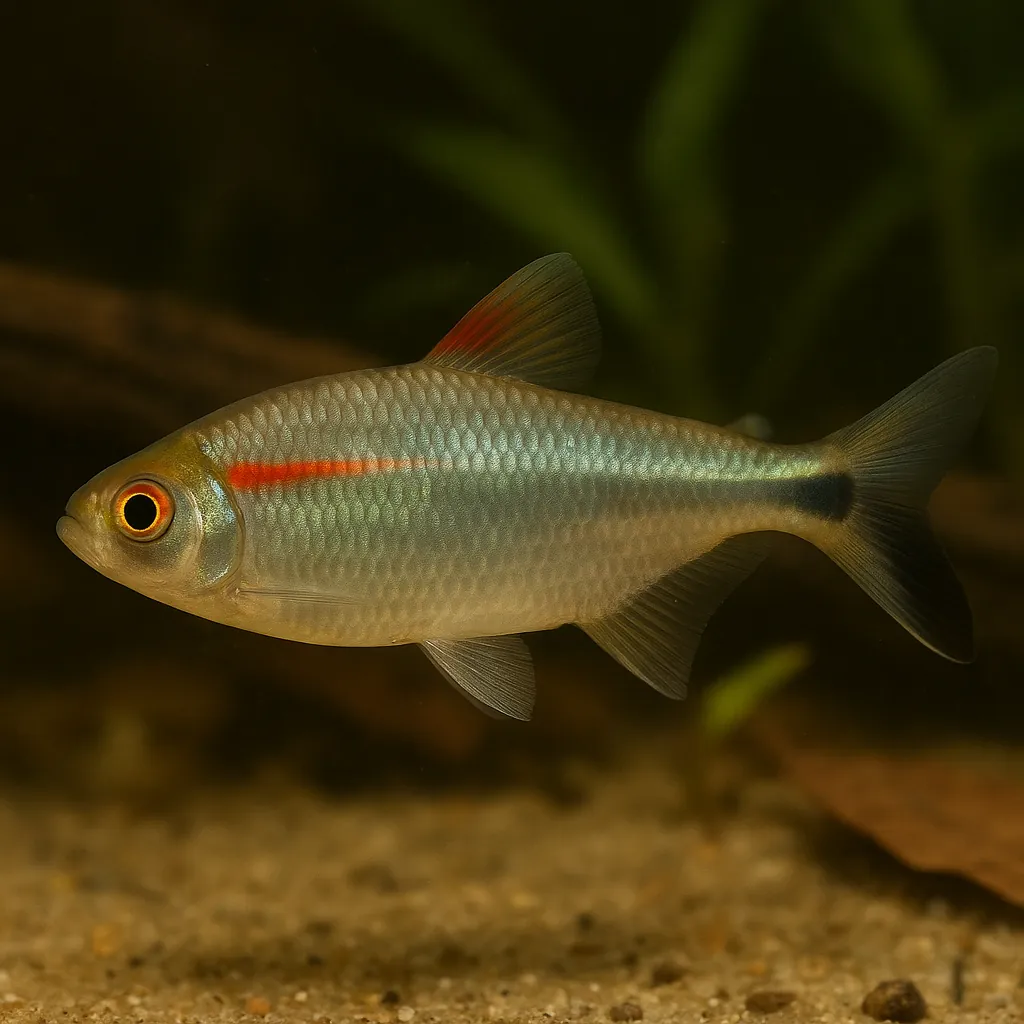
Buenos aires tetra
Introduction
The Buenos Aires tetra (Hyphessobrycon anisitsi) is a vibrant and hardy freshwater fish, cherished by aquarists for its striking silver body accented with red-tipped fins and a distinctive black marking on the dorsal fin. Its resilience and active nature make it an excellent choice for both novice and intermediate fishkeepers. However, potential owners should be aware of its tendency to nip at long-finned tank mates and its appetite for live plants, which may influence tank setup decisions.
Care and Environment
Providing optimal care for the Buenos Aires tetra involves understanding its specific needs and behaviors to ensure a healthy and harmonious aquarium environment.
What is the minimum tank size required for a Buenos Aires tetra?
A minimum tank size of 95 liters is recommended to accommodate a small school of Buenos Aires tetras, as they are active swimmers and thrive in groups.
What are the ideal water parameters for Buenos Aires tetras?
These tetras prefer water temperatures between 18°C and 28°C, with a pH range of 5.8 to 8.5, and water hardness up to 35 dGH.
How should the tank be decorated for Buenos Aires tetras?
Due to their tendency to consume live plants, it's advisable to use artificial plants or select hardy species like Java fern. Incorporating driftwood and rocks can provide hiding spots and mimic their natural habitat.
Regular maintenance is crucial, as Buenos Aires tetras are sensitive to nitrate and phosphate buildup. Performing bi-weekly water changes of 25% to 50% helps maintain water quality.
Feeding should be varied, including high-quality flake foods supplemented with live or frozen options like bloodworms and brine shrimp. Offering vegetables such as lettuce or spinach can also be beneficial.
Origin and Habitat
Native to South America, the Buenos Aires tetra inhabits the Paraná and Uruguay River basins, including regions in Argentina, southeastern Brazil, and Paraguay.
What type of environments do Buenos Aires tetras naturally inhabit?
They are found in various freshwater bodies such as rivers, ponds, lakes, and streams, typically preferring areas with moderate flow and abundant vegetation.
How do seasonal changes affect their natural habitat?
Seasonal variations can influence water levels and temperature, affecting the availability of food and breeding grounds, which in turn impacts their behavior and distribution.
Temperament and Compatibility
Buenos Aires tetras are active and social fish that thrive in groups, but their behavior necessitates careful selection of tank mates.
Are Buenos Aires tetras peaceful community fish?
While generally peaceful, they can exhibit fin-nipping behavior, especially towards long-finned or slow-moving fish.
What are suitable tank mates for Buenos Aires tetras?
Compatible companions include larger tetras like black widow or serpae tetras, as well as barbs, danios, gouramis, and rainbowfish. Bottom-dwelling species can also coexist well.
How can aggression be minimized in a community tank?
Maintaining a school of at least six Buenos Aires tetras can help reduce aggression, as they are less likely to target other species when kept in appropriate numbers.
Interesting Facts
Beyond their care requirements, Buenos Aires tetras possess several intriguing traits that enhance their appeal.
How long do Buenos Aires tetras typically live?
With proper care, they can live up to 5 or 6 years, providing long-term enjoyment for aquarists.
Are there different color variations of Buenos Aires tetras?
Yes, in addition to the standard silver and red coloration, albino varieties and those with yellow tails have been bred, offering diversity for enthusiasts.
What is unique about their breeding behavior?
They are egg scatterers, releasing eggs over plants or substrate without parental care. A single female can lay up to 2,000 eggs, which hatch in approximately 24 hours.
Sources
All information in this article has been gathered from the following reputable sources:
Overview
Recommended Tank Size 25.1 Gallons (L for groups of 6 or more) |
Minimum Group Size 6 |
Minimum Tank Volume 25.1 Gallons |
Maximum Adult Length 3 inches |
Average Adult Length 3 inches |
Shoaling (6+ required) Yes |
Preferred Water Type Freshwater, adaptable to a range of conditions |
Temperature Range (°C) 18–28 |
pH Range 5.8–8.5 |
Water Hardness (dGH) 35 |
Typical Lifespan (years) 5 years |